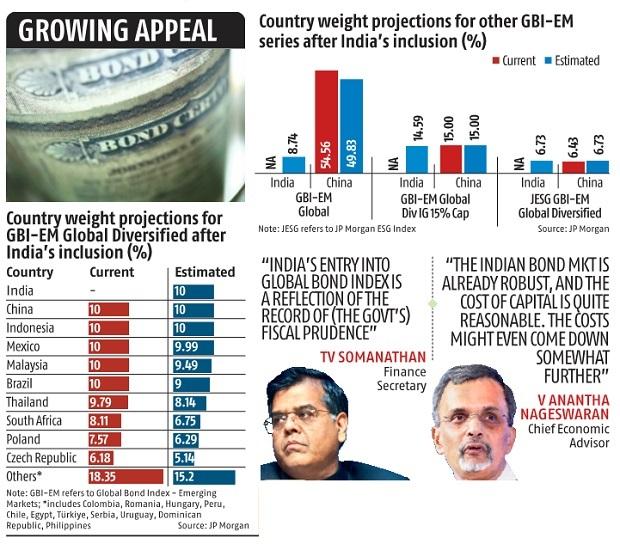The bond market is set to become more attractive for foreign portfolio investors (FPIs) after JP Morgan decided to include government papers issued by the Reserve Bank of India (RBI) under the fully accessible route in its widely tracked emerging market government bond index (GBI-EM). The process will start in June next year.
“India will be included in the GBI-EM Global index suite and all relevant derivative benchmarks (including custom indices), starting June 28, 2024,” JP Morgan said following a 2023 index governance review.
While there was a demand for tax exemption, the government has not offered incentives to foreign investors for the index inclusion.
The inclusion will be phased over 10 months, with 1 per cent weighting included in each month, till March 31, 2025.
Indian bonds, like the Chinese, will have 10 per cent weighting.
With assets under management of $236 billion tracking the index, inflows of $23.6 billion are estimated during this period. A Nomura note said Thailand could bear the brunt of the relocation of resources to India with outflows amounting to $3.6 billion.
“We estimate that India’s inclusion could prompt passive inflows of around $30 billion (comprising EM local dedicated funds, as well as blended funds) over the scale-in period as a one-off stock adjustment. However, given India’s attractiveness from a yield and (low) vol perspective, we think it could attract at least another $10 billion of active flows,” a note from Goldman Sachs said.
The inclusion in the global bond index can lead to lower borrowing costs for both the government and private-sector borrowers. The process of foreign investors converting their currencies into rupees further boosts the demand for the Indian currency, helping stabilise its value.
JP Morgan said India had been on Index Watch Positive since 2021 for inclusion in the GBI-EM, following the government’s introduction of the fully accessible route (FAR) programme in 2020 and substantive market reforms for aiding foreign portfolio investment.
According to the index inclusion criteria, eligible securities are required to have a notional outstanding of above $1 billion and at least 2.5 years’ remaining maturity.
At the start of the inclusion on June 28, 2024, only FAR-designated bonds with a maturity date after December 31, 2026, will be assessed for eligibility. Any new index-eligible FAR-designated bonds issued during the phase-in period will also be included, JP Morgan said.
The Reserve Bank of India introduced the FAR in March 2020, allowing FPIs to invest in bonds without restriction. At present, 23 FAR bonds with a combined value of $330 billion are eligible for inclusion in the index.
India is also expected to enter other JP Morgan bond indices — JADE global diversified index, JESG GBIEM index and other aggregate suite of local currency indices.
The inclusion of FAR-designated government bonds in the GBI-EM Global is estimated to increase index yields by 33 basis points when the process is completed.
The development could mean Indian bonds’ entry into another widely tracked index, the Bloomberg global aggregate index, which could result in inflows of another $15 billion. Typically the review for this index inclusion happens in November, with results being announced in January.
However, India does not meet the credit rating criteria for inclusion in the FTSE WGBI index, which needs ‘A-’ for S&P and ‘A3’ for Moody’s. India has a rating of BBB- by S&P and Baa3 by Moody’s.











